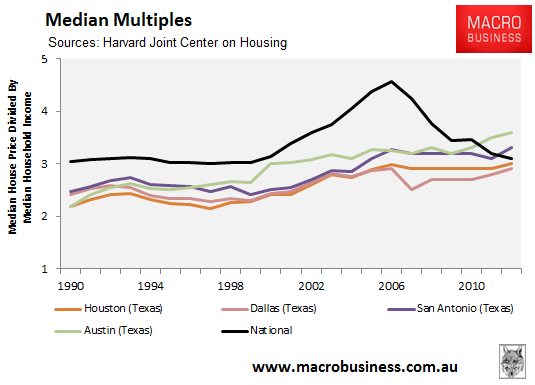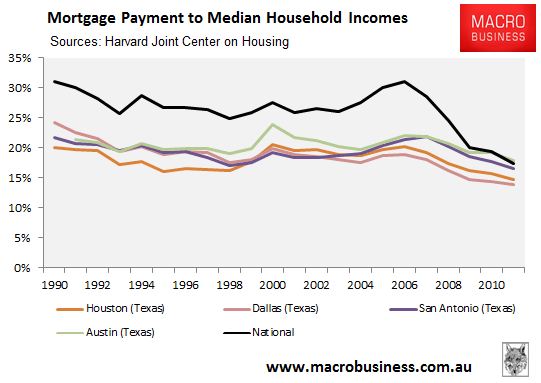
The New Zealand Initiative last week released a brilliant new report entitled Different Places, Different Means: Why Some Countries Build More Than Others, which provides a comprehensive assessment of housing supply systems in four markets: Britain; Switzerland; Germany; and Texas.
As argued by me many times before, the report describes Britain’s housing system “as a case of how not to do things”. Thanks to the Town and Country Planning Act 1946, the right to develop has been virtually nationalised and the country is ruled by NIMBYs – i.e. an “entrenched anti-development culture, where ‘greenbelts’ around the country are considered sacrosanct”. The centralisation of government finances has also led to a situation whereby local governments receive little benefit from increased population and development, but bear most of the costs, making them anti-development.
In the middle are Switzerland and Germany, whose fiscal systems are highly localised, with funding based primarily on the ability to attract population. This incentive makes both countries more amenable towards development, increasing the responsiveness of supply. Right to build laws also assist in this regard.
Then there is Texas, where land-use regulation is particularly permissive, and housing-related infrastructure is provided efficiently via its Municipal Utility District (MUD) bond financing system. These two factors combined have helped make Texas’ housing system highly responsive to changes in demand, leading to affordable housing and low price volatility (see below charts).


Given my previous interest in the Texan housing system, below I have reproduced some of the key extracts from the New Zealand Initiative report explaining the functioning of its housing system. In turn, it provides some useful policy prescriptions for how Australia could free-up supply, in order to get construction moving and provide more affordable housing options. As always, I highly recommend that you read the report for yourself.
Flying over Texas, two things stand out: space and sprawl. It is a bustling state, with record rates of economic growth, barely touched by the global financial crisis, and with one of the highest standards of living in the United States. Annual per capita income is $NZ70,000 and the cost of living is low. One of the key reasons for the growth of Texas is its low-cost housing.
The average price of a house in Austin, regularly rated one of the top five most desirable cities in the United States, is $US187,000. In Houston it is lower. Overall, the average house price to household income ratio (the so-called median multiple) has remained around three. In other words, the average home costs three times the average income. There are several reasons for this, and different cities in the state organise themselves in their own ways; however, what they have in common is a liberal land use law at the edges of cities. There is also a very clever model, becoming more widely adopted, by which new infrastructure can be funded and growth allowed.
Houston is a city with a metropolitan region (greater Houston) of about 6.1 million.89 The strict city boundary itself contains only 2.1 million people. Harris County in greater Houston alone grew by 88,000 people in the year to March 2011–12… Today, Houston is one of the economic growth stories in the United States; high-tech medical research and manufacturing is the biggest employer91; and housing is one of the key drivers of this prosperity. The high standard of living, which includes the ability to buy a house on a modest wage or salary, has been one of the hidden factors behind Texan prosperity over the past decades…
Each city in Texas is different. Some cities such as Dallas and Austin have planned development, zoning, and development attitudes and zoning rules similar to many places in New Zealand.
Houston is the only city without any zoning. Rapid growth stretches the ability of municipal authorities to pay for infrastructure. So Houston and other cities such as Austin have had to look for innovative ways to finance infrastructure. The other important factor in development in Texas in general, and Houston in particular, is that land outside the cities cannot be zoned. It also has a narrow definition and a robust defence of property rights, and a view that the market, by and large, is best placed to deliver housing outcomes. Following these principles, the key legislative development has been the invention and growth of the Municipal Utility District (MUD).
MUDs
A Municipal Utility District (MUD) is a water district set up to provide water services to a defined geographical district. It is a statutory authority with the power to tax its residents for the infrastructure and water services it provides. These services are most often water services: freshwater, wastewater and storm water management…
A MUD has taxing powers, and is run by the elected representatives of its residents who must contract out development services to a developer to manage and build. A MUD can issue bonds off the back of existing value, once some value has been created. Typically, the bonds are issued for a period of 20 to 30 years…
Since land in Texas counties cannot be zoned by law, anyone can propose to set up a new development on his or her own land, but they have to provide the infrastructure. The cities provide most infrastructure within city limits to which residents must hook up, but it is a different story outside the city. All manner of infrastructure needs to be provided in a new development: roads, footpaths, streetlights and water. However, most MUDs are only empowered to provide, and tax for, water infrastructure. In some cases this also means other amenities can be voted on by the resident owners, which are a kind of body corporate.
The process is roughly as follows: a developer or group of landowners go through the process of turning some land into a MUD as described above (note: not all MUDs end up being developed). However, before that can happen some other steps need to be taken. To qualify to be a MUD, land has to have resident owners, so the owner/developer of the land will sell sections to what is known as a ‘developer board’. The land can be sold at a peppercorn rate to get the development off the ground. The developer board will typically be a group of people with useful expertise (an engineer, a lawyer, an accountant, a banker, and so on) that the developer knows. The board is paid on a per-meeting-plus-costs basis, and must be re-elected by the residents of the MUD every two years on a rotating basis.
The resident board (at this point, it is the developer board) votes to form a MUD, creates rules for the development community, decides on what MUD tax they will charge, and contracts a developer to undertake the development. As the development grows, the board may change or stay the same depending on residents’ wishes. In some cases, developer boards stay in charge for decades; in other cases, there is a quick turnover and new residents moving into the community might take over within a short period.
The infrastructure is provided by the developer who may build a first stage, 100 homes for example. Sufficient water and a sewage plant will be built for that, with the option of increasing the capacity. The developer builds the roads, footpaths and other non-water infrastructure. These are included in the price of the house.
Once sufficient value has been created, and say 100 homes are sold, there will be enough value in the development and the future residential tax stream for the MUD to issue a tax-exempt bond to pay for the rest of the construction, which proceeds in stages. The common minimum example given is a 500-house development, with 100 new houses built at a time.
Any bond issue must be signed off by a State-appointed officer once due diligence has been undertaken to make sure that the bond is robust. An assessment is then made that the amount being raised is reasonable based on the construction work that needs to be done. The audit also considers the ability of the current and projected size of the MUD to pay off the bond in time. MUD administrations have developed over time, and one of the key attributes is the high level of trust in a MUD. The State is never expected to act as a backstop for one that has gone awry. MUDs are, in essence, local authorities with limited taxing powers empowered to service water infrastructure.
Of course infrastructure must be paid for. But instead of paying by way of a greater general tax, or the cost of the new construction being front loaded into the house, a MUD, as a statutory taxing authority is empowered to levy a tax to pay for this infrastructure. Here is one of the great advantages of the MUD. Instead of all the water infrastructure costs being loaded into the front price of the house, to be passed on at the point of occupation, a MUD tax involves low payment over time. This has the effect of keeping the price of the new house lower at the point of entry for a young couple. Specifically, by law, a MUD can charge an ad valorem tax of up to 1.5% per $100 of value per year. The amount of this tax reduces over time as the debt is retired. Some MUDs have a tax as low as 16 cents per $100 and a typical tax seems to be around 30 cents per $100 of value, a rate of 0.3% tax on the value of the property.
The tax typically begins at around $1.30–$1.40 of which perhaps $1.10 is debt, which funds the capital; the remainder is the operating cost of the utilities. Those charges are typically run with a modest surplus in mind to pay for utility upgrades, a MUD manager, servicing, repairs, and so on. Over time, if operating surpluses accrue, MUD residents usually vote for some new amenity to be built, often a swimming pool, a park development, or some other public amenity. In theory, the residents could vote to get a MUD operating a surplus to make a refund, but this rarely happens in practice.
A MUD tax is paid on top of other taxes that may be levied by the county or city…
Land-use:
The prioritisation of property rights, their absolute nature, but limited scope in Texas, affects land use. Property rights tend to cover only land; zoning in counties is against the law. Provided a development gets water approval…, it can be started wherever and whenever a person or group wishes to start one. There are environmental protections, but these are prescribed every few years and are generally known before proposals for development are filed. There are few avenues for appeals because it is expected that any areas of environmental sensitivity have already been earmarked and have gone through a separate process of protection…
The burden of providing water infrastructure is thus taken off the City/State, as is the job of working out where new developments should go and where people should live. This leaves the State to concentrate on providing public goods, or generally agreed goods and services such as highways and access to residential areas, and working how to connect them to the different parts of the City and State. All these factors substantially lower the cost of land. There is a variety of developments built in various natural environments aimed at different markets and sold at individual prices. They are held relatively stable by the ability to debt finance infrastructure through tax-free bonds. To give a sense of scale, the Texas legislature in March 2013 (it sits once every two months) enacted 17 MUDs, all of them ready to be developed and started.
This process always keeps the price of land low, with a great deal of competition in land for development and no artificial scarcity. It also keeps the purchase price of a house or section low since the expensive water infrastructure is paid for over time through the MUD tax, not in the upfront cost of a new house. Because a subdivision can be developed virtually anywhere on the fringes of a city, or further out, there is no artificially created scarcity value of land. Instead there is a competitive market in subdivisible land because no landowners have an incentive to ‘land bank’ or speculate against possible future zoning or land use decisions. The contrast between developing in Texas compared with Auckland is stark: the Metropolitan Urban Limit creates scarcities in land and Watercare provides a monopoly water service, the costs of which are charged upfront. In Texas there is no land scarcity, and each development pays for and provides its own water infrastructure, the costs for which are debt funded over time…
In New Zealand, the state (through councils) also plays the roles of planner and adjudicator, cleaving a line between competing interests and views on development. In Texas, the role of planner is largely stripped back, particularly outside the City: the State sets the rules and through various agencies, and ensures they will be followed. In most cases, the rules are relatively clear and the State of Texas/County just sees that they are enforced.
In Texas, rules on water usage and environmental protection are prescribed, and enforcement is largely a technical matter. It is generally assumed that unless there is a compelling argument for a development not to go ahead, which itself is an oddity given the commitment to local property rights, it will be given the green light. The state views itself as regulator, not stakeholder. It simply sees that the laws of the land are complied with. And if not, it helps parties comply with them in order to get their project given the necessary approval. For most applications, there is also a one fee policy: applicants pay once for the consent. If they don’t get it the first time around, they do not need to continue paying council for each subsequent application. This minimizes incentives for officials to decline an application…
Protections for property owners:
Of course there must be some way to protect private property rights that owners can buy into when they get a property, and there is. It is called a deed title and is often called a covenant in New Zealand. Each MUD has its own set of deed restrictions that prescribe how big a house can be, its features, its colour, its location on the section, and so on. These deed titles make more sense in an area like Texas where property rights are far more stringently enforced: by buying into a development with a deed title, people are buying extra protections for their property from being built out or having big trees or a pile of smashed-up cars located next door…
NIMBYs and MUDs:
Most people in the planning or construction community in Houston have never heard of NIMBYs, or if they have, they are more a theoretical concept than a day-to-day aspect of life. One theory for this is that wide open spaces in Texas tend to reduce neighbourhood anxieties; another theory is that the MUD model removes any ambiguity about who is paying for what. In countries such as New Zealand, there seems to be a latent fear (founded in evidence or not) on the part of many locals that ‘we’ are paying for ‘their’ infrastructure. The MUD model clears up any confusion on this issue. People in a MUD pay whatever local taxes they might owe plus their MUD tax for the water infrastructure. A MUD is a good way to mitigate concerns about the public cost of infrastructure.
This leads on to a larger advantage in the MUD model. Because the entire water infrastructure in any new development is paid for by residents moving in they have a great incentive to do two things: 1) keep costs as low as possible, and 2) attract businesses or large employers to set up within the MUD to help pay down its debt. Of course local governments around the world would argue exactly the same, and would be right. However, a MUD is different because it decouples the provision of core services from the other roles that local government play. The difference between a local body and a MUD is that the latter can only tax to a certain level ($1.50 per $100 of value) to pay for certain prescribed things (water infrastructure and provision). Everyone inside the MUD is a part owner of this infrastructure and has every incentive to keep the cost and price down for the customer – themselves. They also have every incentive to welcome developments that might see the price reduce as quickly as possible and stay low, such as permission for businesses to set up in the MUD. There is no question of new developments crosssubsidising other activities that might not be core to a MUD’s purposes or that are contrary to the residents’ wishes.
This means councils cannot blame murky infrastructure financing arrangements for lifting rates or taxes, and can be relieved of providing essential infrastructure services and focusing on civic services such as libraries, parks, museums and so on…
The report also provides detailed case studies of Houston and Austin, which are well worth a read.
With a bit of luck, some open-minded planners and policy makers will read this post and begin examining Texas’ innovative and successful housing system (as well as the those of Germany and Switzerland), and consider applying some of the principles to Australia’s restrictive and constipated planning and land-use regime.
Once again, I cannot recommend this report enough to anyone interested in land-use and affordable housing.

